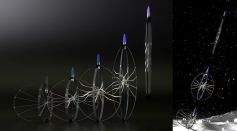TECH & INNOVATION

What Are Hypersonic Missiles? Aerospace Engineer Explains Possible Threats, Unique Features Compared to Next-Gen Weapons

Johns Hopkins Graduate Students Invent a Medical Device That Could Spare Thousands of Cancer Patients Each Year

Fictosexual Man Bids Goodbye to Hologram Wife After Device Support for Virtual Character Ends
Verano to Release U.S. GAAP Fourth Quarter and Full Year 2021 Financial Results on April 27th and First Quarter 2022 Results on May 25th

Satellite Images Show Militarized Dolphin Pens in Russian Naval Base; What Can These Trained Marine Mammals Do to Be Involved in War?

U-Boat Worx Unveils 'NEXUS’ Electric-Powered Commercial Submarines That Can Serve 80 People Per Day

Jumping Robot for Lunar Exploration Can 100 Feet Over Complex Terrains

AI Predicts Early Pancreatic Cancer Development Using CT Scans for Abdominal Pain

AI May Predict Cancer Without Putting Patient Data at Risk

First Air-One 'Vertiport' Unveiled in the UK for eVTOL Transport, Urban-Air Adding Over 200 Sites by 2027

Rykka Care Centre Owned Berkshire Care Centre: An Overview

More Powerful Supercontiuum Light Possible Through Novel Optical Fiber Solution

Small Quadruped Robot "SQuRo" Developed to Mimic Agility of Rats, Can Carry Objects as Heavy as Its Own Weight

Neuralink Brain Chip May Treat Conditions Like Morbid Obesity; But Scientists Say Musk’s Claim Not Possible
Most Popular

Dark Matter Explained: What We Know, What We Don't, and How It Shapes Cosmic Structure

Ocean Acidification, Marine pH Change, and CO2 Absorption: How Coral Reef Damage and Shellfish and Plankton Impacts Threaten Marine Life

Memory and Learning: How the Brain Stores, Retrieves, and Forgets Information

Water, Carbon, and Nitrogen Cycles: How Biogeochemical Cycles Sustain Earth's Ecosystems





